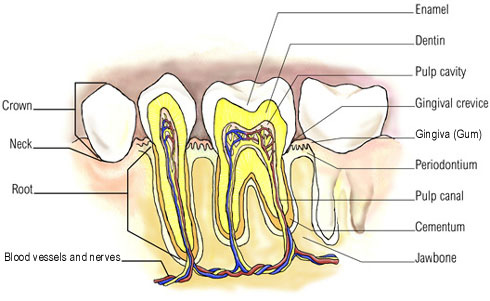We tend to think of teeth as being solid, but they are not. The enamel, although quite hard and durable, has tiny tubules running through it which connect to literally millions of other tubules that permeate the dentin.
All these tubules are filled with fluid that flows constantly between dentin and enamel, and through to the nerve endings and blood vessels in the center of the tooth. This fluid provides a constant exchange of nutrients between the tooth and the rest of the body. To show this dynamic interchange, studies have been done in rats.
A fluorescent dye was injected into the abdomen of rats and within ten minutes the dye was found in the dentinal tubules.
In a healthy mouth, the fluid flow is from the center out through the tubules into your mouth. In other words, your body delivers nutrients and oxygen through your blood stream into the root of the tooth. The tooth gets “nourished” and passes the fluid out the tubules through the dentin into the enamel.
This fluid flow is very important in understanding the process of tooth decay. For decay to occur three conditions must be met; (1) You need a specific type of bacteria (2) you need fermentable carbohydrates; (3) the tooth must be susceptible.
If only the first two are present no decay will take place, or the third can be present, but if you do not have number one or two, no decay will occur. Brushing and flossing help with the first two conditions, but the real key is number three. If the fluid flow is kept in a direction going from the pulp outward decay can be prevented or arrested. This positive outward pressure prevents the penetration of destructive by-products.
This fluid flow will be affected by a number of things. Diet is critical – a diet high in refined sugar will cause the flow to go from outward to inward. Stress and lack of certain vitamins and minerals can also do the same thing. I believe that depending on the health of the tissue and organs relating to specific teeth, the fluid flow will be more or less susceptible to change direction. Thus we see, balancing an overall chemistry is a key step in battling the caries (decay) problem. Combine this with proper home care and you have a dynamic duo.
The most basic purpose of your teeth is to chew food so you can start the digestive process. The average adult person has 32 teeth including the third and last molars commonly referred to as the “wisdom teeth”. The variation in shapes and sizes that are designed for specific functions.
In your cheeks and under your tongue, you have salivary glands from which digestive enzymes are excreted to help the initial breakdown of food while you are chewing.
If the teeth are not thoroughly cleaned after eating, tiny bits of partially digested food can cling to the tooth and continue to break down, becoming a feeding ground for bacteria. This causes plaque, which feels like a sticky substance when you run your tongue along your teeth. The bacteria in the deeper part of the plaque now have an anaerobic (airless) environment and can produce by-products which could possible affect the fluid flow in a specific spot on the tooth.
Plaque is easily removed when it is soft. However, if left to harden, it becomes tartar (calculus, in dental language) and must be scraped off during your routine dental cleaning. Tartar can act as a local irritant, much like pebble in your shoe, causing inflammation in the soft gingival tissues surrounding the tooth. This results in gum disease which is the number cause of people losing their teeth worldwide.
The gingival tissue (gum tissue) surrounds the tooth and provides a covering over the bone in which the tooth is suspended by fibres. This gum tissue is like a loose-fitting collar around the tooth, and normally one can measure with an instrument called a periodontal probe one to two millimeters between the tooth and gum.
Some types of diseases can cause bone loss, which simply means that the bone shrinks somewhat. In that case the gap between the gum tissue and teeth can get bigger and create a pocket. The depth of the pocket will now go beyond the normal 1 -2 mm often being 6 – 10 mm. These bacteria-laden pockets and their toxic by-products can further erode the bone and inflame the gum tissue. Tartar can also build up in the pocket. This is how gum disease progresses.
Dr. BERTRAND R. STUART, DDS



.jpg)








